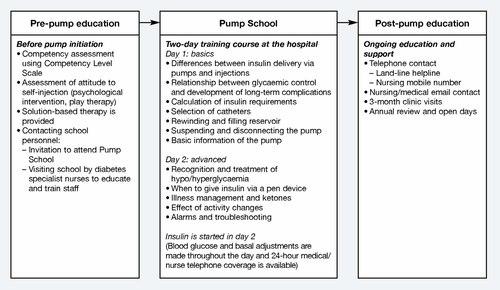下载PDF
{"title":"一个结构化的教育胰岛素泵治疗方案:儿童/青少年及其父母的观点","authors":"Fatemah M Alsaleh BPharm, MSc, PhD, Felicity J Smith BPharm, MA, PhD, FRPharmS, Rebecca Thompson RSCN, BSc, MSc, Kevin MG Taylor BPharm, PhD, MRPharmS","doi":"10.1002/edn.220","DOIUrl":null,"url":null,"abstract":"<p>This study aimed to determine the views and experiences of parents and children regarding the training and services they had received at a London teaching hospital, when the child commenced insulin pump therapy; and to inform future services.</p><p>Face-to-face semi-structured interviews were conducted with children/young people (n=34) aged 5–17 years, using pump therapy, and their parents (n=38). Interviews were audio-recorded, transcribed verbatim and analysed using established qualitative analytical procedures.</p><p>Parents and children/young people had their own concerns on starting pump therapy: constant attachment of the child to an insulin pump and the cannula-insertion procedure respectively, being the greatest concerns. The hospital-based diabetes team supported families to overcome such issues. They provided families with 24-hour telephone contact, contacted schools and nurseries, ran a two-day Pump School at the start of pump therapy and provided ongoing services to ease patients' transition from insulin injections to pumps. The programme and services provided were generally perceived positively by children and parents. However, some limitations were reported and suggestions for improvement were made.</p><p>In conclusion, the insulin pump therapy programme was appreciated by the majority of families, and provided children and their parents with support for easier transition from insulin injections to pumps. As the numbers of young people using pump therapy increase, the results of this study can inform the development of similar services, by considering this programme as a model for establishing such a service in other specialised diabetes centres. Copyright © 2013 FEND. Published by John Wiley & Sons, Ltd.</p>","PeriodicalId":100496,"journal":{"name":"European Diabetes Nursing","volume":"10 1","pages":"25-30"},"PeriodicalIF":0.0000,"publicationDate":"2013-02-27","publicationTypes":"Journal Article","fieldsOfStudy":null,"isOpenAccess":false,"openAccessPdf":"https://sci-hub-pdf.com/10.1002/edn.220","citationCount":"6","resultStr":"{\"title\":\"A structured educational insulin pump therapy programme: the views of children/young people and their parents\",\"authors\":\"Fatemah M Alsaleh BPharm, MSc, PhD, Felicity J Smith BPharm, MA, PhD, FRPharmS, Rebecca Thompson RSCN, BSc, MSc, Kevin MG Taylor BPharm, PhD, MRPharmS\",\"doi\":\"10.1002/edn.220\",\"DOIUrl\":null,\"url\":null,\"abstract\":\"<p>This study aimed to determine the views and experiences of parents and children regarding the training and services they had received at a London teaching hospital, when the child commenced insulin pump therapy; and to inform future services.</p><p>Face-to-face semi-structured interviews were conducted with children/young people (n=34) aged 5–17 years, using pump therapy, and their parents (n=38). Interviews were audio-recorded, transcribed verbatim and analysed using established qualitative analytical procedures.</p><p>Parents and children/young people had their own concerns on starting pump therapy: constant attachment of the child to an insulin pump and the cannula-insertion procedure respectively, being the greatest concerns. The hospital-based diabetes team supported families to overcome such issues. They provided families with 24-hour telephone contact, contacted schools and nurseries, ran a two-day Pump School at the start of pump therapy and provided ongoing services to ease patients' transition from insulin injections to pumps. The programme and services provided were generally perceived positively by children and parents. However, some limitations were reported and suggestions for improvement were made.</p><p>In conclusion, the insulin pump therapy programme was appreciated by the majority of families, and provided children and their parents with support for easier transition from insulin injections to pumps. As the numbers of young people using pump therapy increase, the results of this study can inform the development of similar services, by considering this programme as a model for establishing such a service in other specialised diabetes centres. Copyright © 2013 FEND. Published by John Wiley & Sons, Ltd.</p>\",\"PeriodicalId\":100496,\"journal\":{\"name\":\"European Diabetes Nursing\",\"volume\":\"10 1\",\"pages\":\"25-30\"},\"PeriodicalIF\":0.0000,\"publicationDate\":\"2013-02-27\",\"publicationTypes\":\"Journal Article\",\"fieldsOfStudy\":null,\"isOpenAccess\":false,\"openAccessPdf\":\"https://sci-hub-pdf.com/10.1002/edn.220\",\"citationCount\":\"6\",\"resultStr\":null,\"platform\":\"Semanticscholar\",\"paperid\":null,\"PeriodicalName\":\"European Diabetes Nursing\",\"FirstCategoryId\":\"1085\",\"ListUrlMain\":\"https://onlinelibrary.wiley.com/doi/10.1002/edn.220\",\"RegionNum\":0,\"RegionCategory\":null,\"ArticlePicture\":[],\"TitleCN\":null,\"AbstractTextCN\":null,\"PMCID\":null,\"EPubDate\":\"\",\"PubModel\":\"\",\"JCR\":\"\",\"JCRName\":\"\",\"Score\":null,\"Total\":0}","platform":"Semanticscholar","paperid":null,"PeriodicalName":"European Diabetes Nursing","FirstCategoryId":"1085","ListUrlMain":"https://onlinelibrary.wiley.com/doi/10.1002/edn.220","RegionNum":0,"RegionCategory":null,"ArticlePicture":[],"TitleCN":null,"AbstractTextCN":null,"PMCID":null,"EPubDate":"","PubModel":"","JCR":"","JCRName":"","Score":null,"Total":0}
引用次数: 6
引用
批量引用


